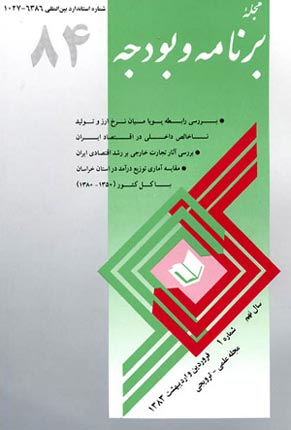فهرست مطالب

فصلنامه برنامه ریزی و بودجه
پیاپی 84 (فروردین و اردیبهشت 1383)
- تاریخ انتشار: 1383/03/15
- تعداد عناوین: 3
-
صفحه 3در مورد اثرگذاری تغییرات نرخ ارز بر تولیدات کشور، نظرهای متفاوتی مطرح شده است. با توجه به اهمیت موضوع در سیاستگزاری ها و امکان اثرگذاری بر تولید از طریق نرخ ارز، در این مقاله رابطه میان نرخ ارز و تولید ناخالص داخلی کشور با روش ARDL در دوره 1338-1379 بررسی شده و الگوی «ادواردز» مبنای اصلی تحقیق است. با کمک متغیرهای توضیحی سرمایه گذاری بخش دولتی و خصوصی، حجم نقدینگی و انواع نرخ ارز تغییرات تولید ناخالص داخلی و میزان اثرپذیری آن مطالعه شده است.
-
صفحه 27تجارت خارجی و ارتباط آن با رشد اقتصادی، یکی از موضوعات بسیار بحث انگیز به ویژه در انتخاب استراتژی های توسعه در کشورهای در حال توسعه است و هنوز بین اقتصاددانان برای این موضوع، که چگونه سیاست های تجاری و نرخ رشد اقتصادیمی توانند ارتباط داشته باشند، توافق وجود ندارد. در نظریه های جدید و الگوهای رشد درونزا، نشان داده شده که تجارت بین الملل (باز بودن اقتصاد) نرخ رشد اقتصاد را از طریق دسترسی به بازارهای خارجی، تکنولوژی و منابع تحت تاثیر قرار می دهد.
-
صفحه 59سطح نابرابری اقتصادی (درآمد یا هزینه) در استان پهناور خراسان معلوم نبوده است. در این تحقیق روند نابرابری هزینه (درآمد) در استان خراسان و کل کشور به تفکیک مناطق شهری و روستایی، در دوره 1350-1380 برآورد، و مقایسه شده است. برای این منظور شاخص های نابرابری (ضریب جینی و سهم دهک های درآمدی) به روش پارامتریکی برآورد گشته است. نتایج حاصل از ارزیابی روند توزیع درآمد (ضریب جینی) و آزمون فرضیه ها حاکی از آن است که بین سطح نابرابری اقتصادی مناطق شهری و روستایی استان خراسان، و همچنین بین آنها با مناطق شهری و روستایی کل کشور، از نظر آماری، اختلاف معناداری وجود نداشته است
-
Page 3Different viewpoints have been expressed on the effects of foreign exchange rate fluctuations on Iran's productions. Given the importance of this issue on policymaking and the possibility of affecting the production through foreign exchange rate, this paper tries to examine the relationship between foreign exchange rates and gross domestic products in Iran's economy by ARDL method within 1959-2000, and "Edwards" model has been taken as the base of the research. Iran's GDP fluctuations and the extent of its affectability have been studied with the help of governmental and private sectors investment explanatory variables, liquidity volume and the variety of foreign exchange rate. According to this research, contrary to many viewpoints expressed about Iran's economy, there is a negative though weak relation between real foreign exchange rate and Iran's products in a way that Iran's products do not show increase with the foreign rate decrease of the national currency (real foreign exchange rate does not have much effect on the production increase. Impulse response functions and analysis of variance were considered for examining the ways of Iran's GDP fluctuations that reaffirmed the previous conclusions.
-
Page 27Foreign trade and its relation to economic growth is one of the very controversial subjects especially when it comes to choose among the development strategies in the developing countries, and still there is no consensus among economists as to how trade policies are related to economic growth rate. In the modern theories and endogenous growth models, international trade economic openness affects economic growth rate through getting access to foreign markets, technology and resources. The spotlight of this paper is on analyzing the effects of international trade on ecomomic growth. Having analyzed the literature and theoretical fundamentals of trade and production, the growth of trade transactions volume has been more than that of world production. This, in turn, shows that world production is made mostly according to the trade motivations, and hence the outward-oriented approaches to the world economic growth and development have gained more importance. Meanwhile, it was revealed that Iran's share in imports and exports is little in proportion to the world, and in the imports composition, there has been too much reliance on intermediate and imports composition, there has been too much reliance on intermediate and capital for a long-run period. Iran's exports concentration and high share of oil in its commodities exports are indicatives of insufficient variety and underdevelopment of national production structure as well as the fragility and vulnerability of trade in the country's economy. The results of model evaluation for the period within 1966-2001 by ARDL method indicated that international trade in the framework of "economic openness tate" indicator has positive effect on Iran's per capita GDP growth.
-
Page 59The level of ecomomic (income or Expenditure) inequality in Khorasan province has been unknown. This paper tries to estimate and compare the trends of expenditure (income) inequality in Khorasan province and the whole Iran during 1971-2001 in two categories of urban and rural regions. For this purpose, inequality indices (Gini coefficient and income deciles) were estimated parametrically. The results of income distribution trend (Gini coefficient) and test of hypotheses indicate that there has been no statistically significant difference between economic inequality levels of urban and rural areas in Khorasan province and between these areas and the whole country.

